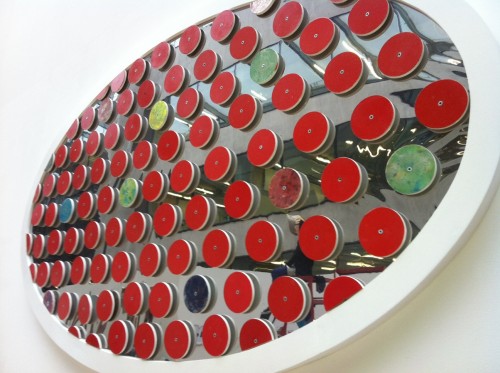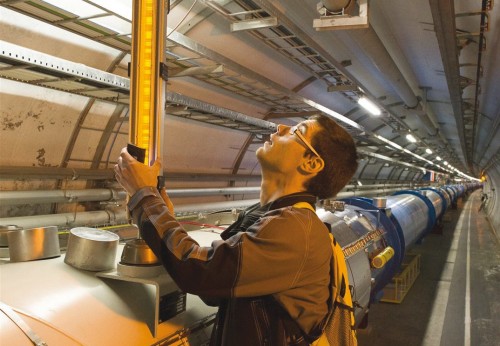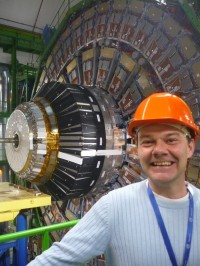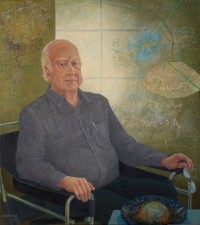Tag archives: CERN
LHCb and CMS see rare decay of the strange B meson

A strange B meson decay event as seen by CMS. (Courtesy: CERN)
By Hamish Johnston
It’s a story with a hint of both “man bites dog” and “dog bites man” about it.
Physicists working on the CMS and LHCb experiments at CERN have independently seen an incredibly rare decay of a particle – a strange B meson decaying into two muons. The odds of this meson decaying in this particular way is about one in a billion, making the joint discovery a triumph of experimental particle physics. And it is officially a discovery. That’s because when data from the two experiments are combined the observation has a statistical significance of greater than 5σ, which is the gold standard in particle physics.
View all posts by this author | View this author's profile
Explaining CERN, the Higgs and the LHC
By Matin Durrani
How well would you do if someone asked you to explain the Higgs boson or the Large Hadron Collider (LHC) at CERN?
If you’re a physicist, you’ll probably find it hard enough. But if you’ve never done any physics in your life, things must surely be trickier still, more so if a film crew from Physics World has shoved a camera up your nose.
These two short videos show the results of a straw poll of randomly selected visitors at last summer’s Bristol International Balloon Fiesta when we asked them to describe the Higgs boson and the LHC.
The reason we were at the fiesta is that we were making a separate film about a project by Bristol University physicist Dave Cussans where school students were measuring cosmic rays during a hot-air balloon flight – it being the centenary of Victor Hess’s discovery of these rays in a balloon flight in central Europe.
View all posts by this author | View this author's profile
CERN teams up with EUROVISION to inspire the next Peter Higgs
By James Dacey

CERN is seeking to inspire tweens in science. (Courtesy: iStockphoto)
I must confess that I was not aware of this partnership, and I must admit it’s not a partnership I would have seen coming. CERN has teamed up with the organization behind the Eurovision Song Contest, in awarding grants to two multimedia companies to develop content that can spark the scientific curiosity of “tweens”.
Okay, let’s back up a second and define a few terms in this equation. Tweens are described by CERN as children aged 8 to 12; not quite teenagers but no longer big babies either. My teacher friends will shoot me down in flames for this cod-pedology but I guess this age group is old enough to be excited by science but not yet old enough to start truly engaging with scientific concepts.
View all posts by this author | View this author's profile
New portrait of Peter Higgs unveiled
By Tushna Commissariat
The Royal Society of Edinburgh (RSE) has just unveiled a portrait of famed physicist Peter Higgs, at the Society’s Fellows’ Summer Reception last week. The painting, which will hang on the walls of the Kelvin Room within the RSE’s premises in Edinburgh, was commissioned to one of Scotland’s leading artists, Victoria Crowe, “to honour the man whose outstanding research was instrumental in [the Higgs boson’s] discovery”. The professor seems distinctly unperturbed by the high-energy proton–proton collision taking place in the top right corner of the painting. I shall leave you to find and discern the other interesting imagery in the painting for yourselves – click on the thumbnail to view a larger picture of the portrait.
Is creativity as important in science as it is in art?
By James Dacey

“Parity Series, Far Infrared”. (Courtesy: Mehri Imani, Central Saint Martins)
The worlds of art and science came together yesterday in central London in a celebration of creativity across disciplines. A symposium at Central Saint Martins College of Art and Design was held to recognize the first group of students to complete the Art and Science MA course – the first course of its kind in the UK. Students taking this course are given the chance to explore the “creative relationships between art and science and how to communicate them”.
View all posts by this author | View this author's profile
Magnet matters at the LHC

Hard at work at the LHC (Courtesy: CERN/Samuel Morier-Genoud)
By Hamish Johnston
Recently I had the pleasure of speaking to CERN’s Steve Myers who is supervising the herculean task of upgrading the superconducting magnets that guide protons around the Large Hadron Collider (LHC).
View all posts by this author | View this author's profile
What do you most hope the LHC will discover after it is switched back on in 2015?
By James Dacey

Admiring the insides of the CMS detector at CERN.
My colleague, Hamish Johnston, has just returned from a trip to CERN, where he was granted access to the insides of the Large Hadron Colider (LHC), which is currently being upgraded. He has shared some great photos from his trip on the Physics World Facebook page, including some snaps of the interior of the detector experiments.
CMS in all its glory

Admiring CMS.
By Hamish Johnston at CERN
Today I had the immense good fortune of seeing the insides of the CMS detector at CERN.
The huge detector was pulled open and I could see all the various layers that are used to track the vast numbers of particles that are produced when protons collide at the Large Hadron Collider.
Unlike earlier photos of the detector that were taken when it was being built, the beamline is still intact as it passes through the CMS – a plain black conduit suspended many metres above the floor. You can see the beamline poking out from the centre of the detector in the photo on the right.
Imperial College’s Jim Virdee was our tour guide, and he told us how several military technologies from the former Soviet Union have been put to good use in the detector. These include brass shell casings that were melted down to make components for the detector.
View all posts by this author | View this author's profile
Particle physics comes alive on a tablet

Home page of The Particles app. (Courtesy: Science Photo Library)
By Hamish Johnston
The physicist and best-selling author Frank Close has joined forces with Michael Marten – founder of the Science Photo Library (SPL) – and CERN Courier editor Christine Sutton to create a new app about particle physics. Called The Particles, the app is billed as an introduction to the Standard Model and is aimed at a wide audience that includes professional physicists, students and even amateur enthusiasts.
Spot-on the Standard Model
By Hamish Johnston
“Beyond any reasonable doubt, it is a Higgs boson, and here we examine the extent to which its couplings resemble those of the single Higgs boson of the Standard Model.”
That’s taken from the abstract of a new paper by John Ellis and Tevong You of King’s College London. Ellis, of course, has been associated with CERN for decades and if he says it’s a Higgs that’s good enough for me!
View all posts by this author | View this author's profile
